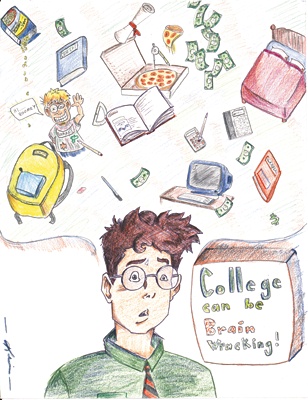All Nonfiction
- Bullying
- Books
- Academic
- Author Interviews
- Celebrity interviews
- College Articles
- College Essays
- Educator of the Year
- Heroes
- Interviews
- Memoir
- Personal Experience
- Sports
- Travel & Culture
All Opinions
- Bullying
- Current Events / Politics
- Discrimination
- Drugs / Alcohol / Smoking
- Entertainment / Celebrities
- Environment
- Love / Relationships
- Movies / Music / TV
- Pop Culture / Trends
- School / College
- Social Issues / Civics
- Spirituality / Religion
- Sports / Hobbies
All Hot Topics
- Bullying
- Community Service
- Environment
- Health
- Letters to the Editor
- Pride & Prejudice
- What Matters
- Back
Summer Guide
- Program Links
- Program Reviews
- Back
College Guide
- College Links
- College Reviews
- College Essays
- College Articles
- Back
Teens' Guide to College & Career Planning by Justin Ross Muchnick
I was searching for a book to try to answer all of the questions I still have about the college admission process, as I myself prepare to submit my own college application this fall. When I found Teens' Guide to College & Career Planning online, I was pleased to find that my library system had a copy and immediately requested it. Upon reading it, I was more than satisfied by the advice given by author Justin Muchnick, a senior at Phillips Academy Andover at the time of this edition’s publication in 2015. Muchnick clearly explains the entire college process, starting with the do’s and don’ts of high school, advice on how to productively spend the summers between schoolyears, where to find internships, writing the college essay, choosing a career, and tips for a job or college interview, all culminating with a section dedicated to finding success in the workforce. The book is divided into four different parts, with different chapters delving into more specific subtopics. The first section, entitled “Transitioning to High School…” provides helpful strategies to develop habits that will reflect positively on a college application. Although my high school journey is nearly complete, I still found a lot of this information to be relevant to me as a senior, in conjunction with Part Two, “Jump-Starting Your Future,” especially the links to websites that provide information on careers and summer activities or internships, as well as a high school roadmap, which can serve as a detailed checklist throughout the four years of high school. Part Three, “The Road to More Education” (which could really be entitled “College 101”) provides everything a student needs to know about the college application, SAT and ACTs, choosing colleges and college interviews. This segment is especially pertinent to rising high school juniors and seniors who are looking for clarifications on some rather specific college topics. Part 4, “You and the Workplace” gives practical advice for the “real world” and living on your own. I felt that this section was slightly lacking, but I suppose the book is primarily for “college and career planning” not so much jobs and after college. I really liked how the author acknowledges alternative options for students throughout the entire book, aside from attending traditional four-year colleges such as joining the military, vocational careers, transferring from a community college, the “gap year” option and studying abroad. I feel that all too often high school guidance counselors and parents place too much emphasis on furthering a student’s education solely through college, meanwhile these other alternatives after high school are just as promising for some students and may in fact lead to greater success in life for many students in just as, if not more, honorable professions. I really feel that all high school students would really benefit from reading this book, and that each segment should almost be required summer reading for each grade of high school since many aspects of the college process really do begin as soon as a student enters ninth grade, such as clubs, GPA and even considering potential careers. At the very least it should definitely be readily available in the guidance department for those who are just curious or seeking an overall representation of the college process ahead.

Similar Articles
JOIN THE DISCUSSION
This article has 0 comments.

I read this book because I myself am super nervous about the college process and was seeking just one resource that could hopefully appease most of these fears. Luckily it did!